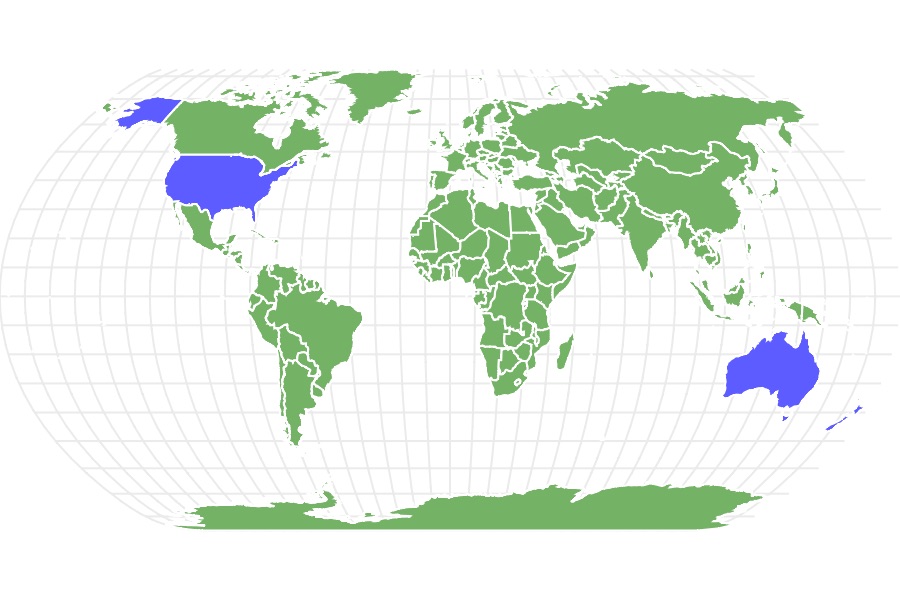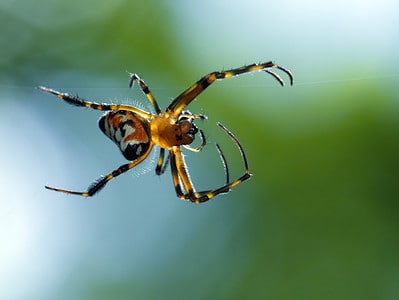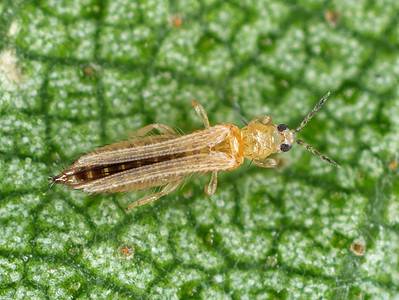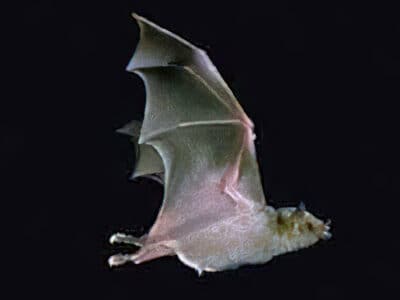Gypsy Moth Caterpillar
Lymantria dispar
Gypsy moth caterpillars have been known to defoliate entire forests!
Advertisement
Gypsy Moth Caterpillar Facts
- Prey
- tree leaves
- Main Prey
- oak leaves
- Name Of Young
- N/A
- Group Behavior
- Solitary/Group
- Infestation
- Fun Fact
- Gypsy moth caterpillars have been known to defoliate entire forests!
- Estimated Population Size
- Undetermined
- Biggest Threat
- Pesticide
- Most Distinctive Feature
- appetite
- Distinctive Feature
- spiky setae (hairs)
- Other Name(s)
- spongy moth
- Gestation Period
- N/A
- Temperament
- docile
- Wingspan
- N/A
- Training
- N/A
- Optimum pH Level
- N/A
- Incubation Period
- N/A
- Age Of Independence
- birth
- Age Of Fledgling
- N/A
- Average Spawn Size
- N/A
- Litter Size
- N/A
- Habitat
- forests, urban and suburban gardens
- Predators
- wasps, birds, squirrels, skunks, raccoons, beetles, flies
- Diet
- Herbivore
- Average Litter Size
- N/A
- Lifestyle
- Diurnal
- Favorite Food
- oak leaves
- Type
- Lymantria dispar
- Common Name
- gypsy moth caterpillar / spongy moth caterpillar
- Special Features
- appetite
- Origin
- Europe, Asia
- Number Of Species
- 2
- Location
- Global
- Slogan
- N/A
- Group
- eclipse
- Nesting Location
- trees
- Age of Molting
- the spongy moth caterpillar molts several times throughout its growth and development.
Gypsy Moth Caterpillar Physical Characteristics
- Color
- Black
- White
- Tan
- Dark Brown
- Cream
- Multi-colored
- Skin Type
- Exoskeleton
- Lifespan
- 1 week - 1 year
- Weight
- 0.018 -0.105 ounces
- Height
- 0.25-0.5 inches
- Length
- 1.5-2.5 inches
- Age of Sexual Maturity
- N/A
- Age of Weaning
- N/A
- Venomous
- No
- Aggression
- Low
View all of the Gypsy Moth Caterpillar images!
The gypsy moth caterpillar is the larval stage of the gypsy moth (Lymantria dispar), a species of moth that is native to Europe and Asia. The caterpillars are known for their voracious appetites and have been known to defoliate entire forests. They are considered a pest species in many parts of the world. Keep reading to learn more about these pesky caterpillars.
Five Fundamental Facts about Gypsy Moth Caterpillars
- The gypsy moth caterpillar is the larval stage of the gypsy moth (Lymantria dispar), a species of moth that is native to Europe and Asia.
- On March 2, 2022, the Entomological Society of America rechristened Lymantria dispar spongy moth.
- Gypsy moth caterpillars are known for their voracious appetites and have been known to defoliate entire forests.
- They are considered a pest species in many countries, including the United States.
- They are active during the day feeding on the leaves of trees and shrubs, such as oak, apple, and willow.
Gypsy Moth Caterpillars: History
Gypsy moth caterpillars are native to Europe and Asia. They were introduced to North America in the late 1800s by a man named E. Leopold Trouvelot. Trouvelot brought the insects to North America from Europe in an attempt to breed a hardier silkworm. Some of the moths escaped from Trouvelot’s breeding facility in Massachusetts. The population quickly spread throughout the Northeastern United States. In the ensuing years, the gypsy moth has spread to other parts of the country and is now found in many states, including Michigan, Wisconsin, and Oregon. The gypsy moth is considered a pest species in North America because it feeds on the leaves of a wide variety of trees and shrubs, often defoliating entire forests.
In general, the impact of gypsy moths in their native countries is considered to be less severe than in areas where they have been introduced. The population of gypsy moths is kept in check by a variety of natural predators and parasites in their native range, as well as by the presence of other species that compete for food resources. Additionally, trees and other plants that are native to Europe and Asia have evolved to tolerate gypsy moth feeding to some degree.
Invasive Species
These insatiable eaters are equal-opportunity destroyers, causing damage to ecosystems around the globe. Countries where gypsy moths have been reported as invasive include:
- Canada: Gypsy moths have been reported as invasive in many parts of Canada, particularly in the provinces of Quebec, Ontario, and British Columbia.
- Australia: Gypsy moths were first reported in Australia in the late 1800s, and since then, have been found in most states and territories.
- New Zealand: Gypsy moths were first reported in New Zealand in the early 1900s and have since spread throughout the country.
- South Africa: Gypsy moths were first reported in South Africa in the early 1900s, and have since spread to most parts of the country.
- Japan: Gypsy moths were first reported in Japan in the early 1900s and have since spread to most parts of the country.
- Russia: Gypsy moths were first reported in Russia in the early 1900s, and have since spread to most parts of the country.
Methods of Control
There are several methods that can be used to control invasive gypsy moth caterpillar populations, including:
- Biological control: This involves the use of natural predators, such as birds and parasitic insects, to reduce the population of gypsy moths.
- Pesticides: Various types of pesticides, such as Bacillus thuringiensis (Bt) and insecticidal soap, can be used to control gypsy moth populations.
- Mating disruption: Pheromone-based methods can be used to disrupt the mating of gypsy moths, reducing the number of eggs laid as well as the resulting population of caterpillars.
- Cultural control: This includes removing leaf debris and other potential gypsy moth habitats, and maintaining a healthy, diverse ecosystem.
- Physical Control: Using sticky bands around trunks of trees prevents caterpillars from climbing up them; burlap bands are used to catch crawling caterpillars who are seeking shelter from the elements. It is recommended that these traps be emptied daily.
- Chemical Control: Using chemical pesticides like carbaryl, permethrin, or bifenthrin to spray on the leaves, trunk, or burlap bands reduces the spread of gypsy moth caterpillars.
Gypsy Moth Caterpillar: Scientific Name
Lymantria dispar is the binomial scientific name for the gypsy moth in all of its forms, including its larval stage. Translated from Latin their name means Destroyer (Lymantria) unequal (dispar). A more fitting name there could not be for these destructive insects.
After retiring the common name gypsy moth in the summer of 2021, on March 2, 2022, the Entomological Society of America rechristened Lymantria dispar spongy moth, a nod to the sponge-like appearance of their egg sacks. The former name was retired, as the word gypsy is considered a derogatory term, especially by the Romani, a group of traditionally itinerate people.
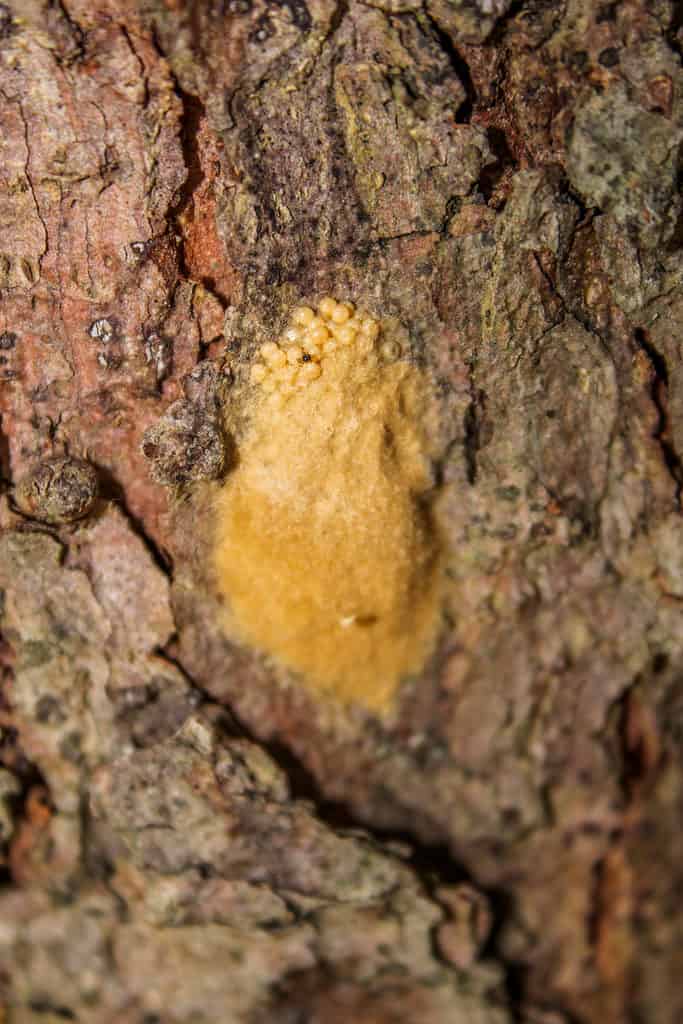
The Entomological Society of America has rechristened
Lymantria disparspongy moth, a nod to the sponge-like appearance of their egg sacks.
©Carolyn Sebestyen/Shutterstock.com
Appearance
Gypsy moth caterpillars are typically mottled with brown to gray to black markings. Their bodies are covered with tufts of hair, known as setae (seta, singularly) They have five pairs of prolegs, the fleshy, unjointed legs found on the abdominal segments of the caterpillar. These caterpillars have a distinct appearance with five pairs of blue spots and six pairs of red spots on the back of their bodies. They also have longer, stiffer setae (hairs) protruding from their body, which can cause irritation to human skin, though they are not venomous.
These caterpillars have a characteristic look with a black head and their body is covered by fine hair. They are typically around 2.5 inches in length and weigh between 0.018 – 0.105 ounces. However, it is worth noting that the size and weight of the caterpillars can be affected by many factors, such as temperature, humidity, availability of food, and their stage of development.
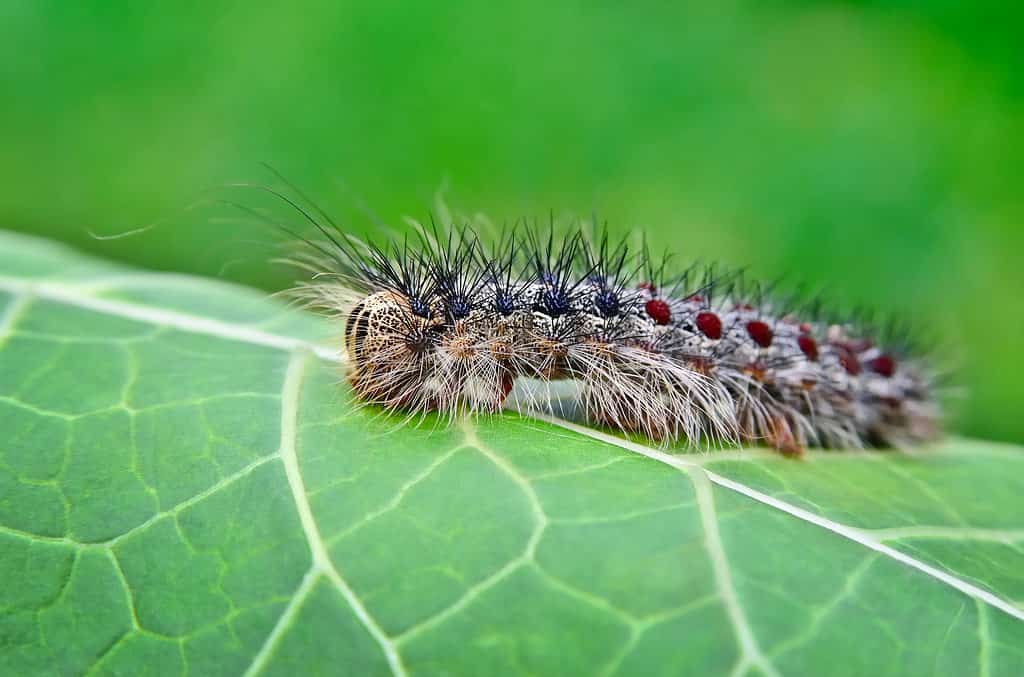
These caterpillars have a distinct appearance with five pairs of black spots and six pairs of red spots on the back of their bodies.
©Oleksandrum/Shutterstock.com
Behavior
Gypsy moth caterpillars are active during the day and feed on the leaves of trees and shrubs, such as oak, apple, and willow. They are voracious eaters and can quickly defoliate entire trees, and even entire forests, causing significant damage to the ecosystem. They move around a lot, crawling on the leaves or branches of trees or shrubs, or on the ground.
In their early stages, they tend to cluster together, and as they grow older, they spread out to feed on more leaves. When they are disturbed, they tend to curl up into a tight ball, as a defense mechanism.
During late spring and early summer, gypsy moth caterpillars can cause significant damage to trees, shrubs, and other plants. They are considered a pest species in many parts of North America causing major damage to forest ecosystems.
Gypsy Moth Caterpillar: Habitat
Since being introduced to North America, the gypsy moth caterpillar is now found in many parts of the United States, Canada, and Mexico. They are most common in the Northeastern United States but have also been reported as far west as Oregon. Gypsy moth caterpillars are found in a variety of habitats, including many different types of forests: deciduous, mixed, and coniferous. They are also prevalent in urban, suburban, and rural areas where they feed on ornamental plants and trees. Gypsy moth caterpillars prefer wooded areas and are found on a wide variety of trees and shrubs.
Diet
Gypsy moth caterpillars are particularly fond of oak trees and can cause significant damage to oak forests. They have been known to defoliate entire forests, which can have a significant impact on the ecosystem. They feed on leaves during the day and are able to eat them in large quantities. Besides oak leaves, gypsy moth caterpillars will eat the leaves of apple, willow, poplar, and birch. They also feed on the needles of pine, spruce, and hemlock trees. Though they prefer tree leaves, gypsy moth caterpillars are not true herbivores. These caterpillars are generalist eaters, consuming whatever is available.
Predators
Gypsy moth caterpillars have several natural predators that help keep their population in check. Birds such as the Baltimore oriole, cedar waxwing, and several species of warblers, are known to feed on gypsy moth caterpillars. Small Mammals like squirrels, raccoons, and skunks also feed on gypsy moth caterpillars. Insects such as ladybugs, lacewings, and praying mantises will also eat gypsy moth caterpillars. Some species of parasitic wasps, such as the parasitoid wasp Apanteles melanoscelus, lay their eggs inside gypsy moth caterpillars, which then hatch and feed on the caterpillar from the inside. Beetles like the six-spotted tiger beetle and the green tiger beetle will also feed on gypsy moth caterpillars. Tachinid flies will lay their eggs on gypsy moth caterpillars, which then hatch and feed on the caterpillar.
While these predators can help to control the gypsy moth population, they are often not enough. Methods such as biological control, or chemical control may be required to effectively manage the gypsy moth caterpillar populations.
Threats
Gypsy moth caterpillars are susceptible to a variety of parasitic wasps and flies, which lay their eggs inside the caterpillars. The wasp or fly larvae then hatch and feed on the caterpillar from the inside. They are also susceptible to a variety of diseases. Fungus Entomophaga maimaiga can kill large numbers of caterpillars. Gypsy moth caterpillars are affected by weather conditions. During their pupal stage, they are vulnerable to cold temperatures, drought, and flooding. Pesticides are a known threat and are often used to control their population. Gypsy moths also face competition for food and predation by native species, which can limit their population growth.
All these factors can affect the population of gypsy moth caterpillars. However, they are not always enough to keep their population in check. In areas where the population is particularly high, other methods must be employed. These include biological control, chemical control, or physical control (see history) may be required to effectively manage the population.
Conservation Status
The gypsy moth is not listed as an endangered or threatened species under the US Endangered Species Act. However, it has been classified as an invasive species in countries to which it is not native. The species is considered a pest in many parts of North America. This is due to the extensive defoliation of trees caused by the caterpillars. The significant threat of damage that the caterpillars pose to trees and forests, subjects them to control efforts by government agencies. These efforts include the use of biological control methods such as the release of parasitic wasps and diseases. They also use chemical methods, a/k/a pesticides.
Lifecycle
The gypsy moth goes through a complete metamorphosis. This metamorphosis consists of four distinct stages: egg, larva, pupa, and adult.
The adult gypsy moths emerge from their cocoons in late spring or early summer. The females then lay their eggs in masses. Eggs are generally deposited on the bark of trees However rocks, buildings, or any other sheltered area might be used. The eggs are covered in a tan or grayish-white fuzzy material that helps protect them from the elements. The eggs overwinter and hatch the following spring.
When the eggs hatch, the tiny caterpillars emerge and begin to feed on the leaves of trees and shrubs. The young caterpillars are small and pale in color, but as they grow and molt, they become larger and darker. They are active during the day and feed voraciously, quickly defoliating entire trees and even entire forests. These caterpillars are responsible for significant damage to the ecosystem.
As the caterpillars mature, they spin a cocoon and enter the pupal stage, which lasts for about two weeks. During this stage, the caterpillars undergo a dramatic transformation, developing into adult moths. After two weeks, the adult moths emerge from the cocoons. Males will fly searching for females to mate with. Once mated, the females will lay their eggs, starting the cycle again. The adult moths do not feed and their only purpose is to reproduce and lay eggs.
Lifespan
The lifespan of a gypsy moth caterpillar is approximately one year. Lifespans vary depending on environmental conditions such as temperature, humidity, and availability of food. After hatching from the eggs in the spring, the caterpillars go through several stages of growth. These stages are called instars, in which they molt and increase in size.
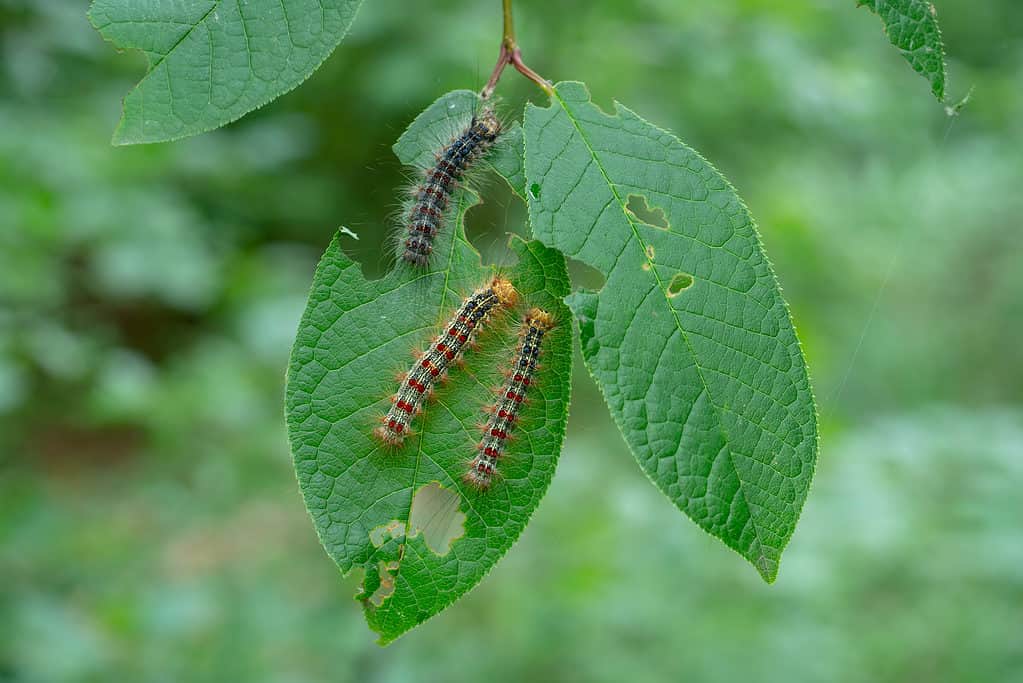
Gypsy moth caterpillars are active during the day and feed voraciously, quickly defoliating entire trees, and even entire forests!
©Evgeniy_16/Shutterstock.com
Population
It is difficult to estimate the total population of gypsy moth caterpillars globally, as the population can fluctuate widely. Population is affected by various factors such as weather conditions, natural predators, and human control efforts. Due to the complexity of monitoring gypsy moth populations, and the fact that populations can fluctuate greatly from year to year, it’s hard to provide a general population estimate. However, it is important to note that populations can grow rapidly, and in high-population years they can cause extensive damage to forests, orchards, and other vegetation.
UP Next:
View all 170 animals that start with GGypsy Moth Caterpillar FAQs (Frequently Asked Questions)
Are gypsy moth caterpillars venomous?
No! Gypsy moth caterpillars are not venomous. They do have tiny setae (hairs) on their body that can cause irritation or allergic reactions in some people if they come into contact with the skin or are inhaled, but they do not produce venom.
Are gypsy moth caterpillars native to North America?
No, gypsy moth caterpillars are not native to North America. They are an introduced species that wreak havoc on plants. From defoliating entire forests to munching on backyard ornamentals, these critters are considered pests.
How big are gypsy moth caterpillars?
The size and weight of gypsy moth caterpillars vary according to the stage of development they are in. Generally speaking, however, they are not very large. In their final instar (molting) before spinning a cocoon, gypsy moth caterpillars are between 1.5 – 2.5 inches long and weigh less than 1 ounce.
What do gypsy moth caterpillars eat?
Gypsy moth caterpillars are known to be particularly fond of oak trees and can cause significant damage to oak forests. Besides oak leaves, gypsy moth caterpillars will eat the leaves of apple, willow, poplar, and birch. They also feed on the needles of pine, spruce, and hemlock trees. Though they prefer tree leaves, gypsy moth caterpillars are not true herbivores. The caterpillars are classified as generalist eaters, consuming whatever is available.
Where do gypsy moth caterpillars live ?
Gypsy moth caterpillars are found in a variety of habitats, including many different types of forests: deciduous, mixed, and coniferous. They are also prevalent in urban, suburban, and rural areas where they feed on ornamental plants and trees.
Thank you for reading! Have some feedback for us? Contact the AZ Animals editorial team.
Sources
- Illinois.edu, Available here: https://web.extension.illinois.edu/gypsymoth/biology.cfm
- ncagr.gov, Available here: https://www.ncagr.gov/PLANTINDUSTRY/plant/entomology/GM/GMidentification.htm
- wikipedia.org, Available here: https://en.wikipedia.org/wiki/Lymantria_dispar_dispar
- globalnews.ca, Available here: https://globalnews.ca/news/7948202/gypsy-moth-caterpillars-ontario-trees/
- cnn.com, Available here: https://www.cnn.com/2021/07/04/us/gypsy-moths-northeast-vermont-scn/index.html
- nps.org, Available here: https://www.nps.gov/isro/learn/nature/invasive-species-gypsy-moth.htm
- invasives.org.au, Available here: https://invasives.org.au/insect-watch/gypsy-moth/
- entsoc.org, Available here: https://www.entsoc.org/publications/common-names/spongy-moth
- nih.gov, Available here: https://www.ncbi.nlm.nih.gov/pmc/articles/PMC6137135/

